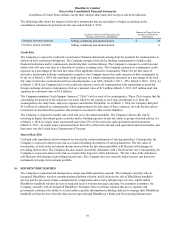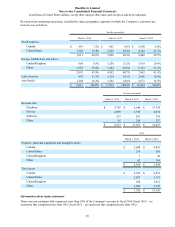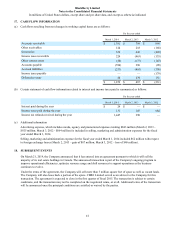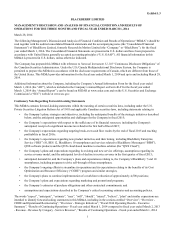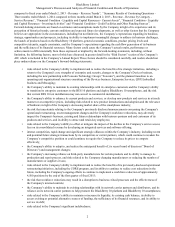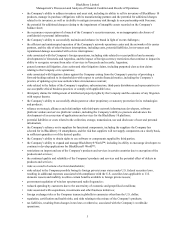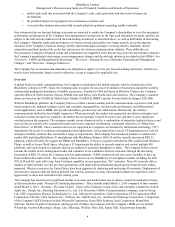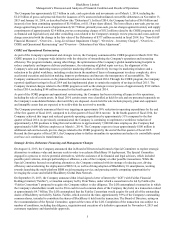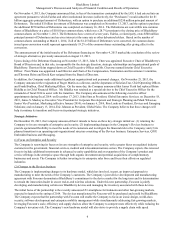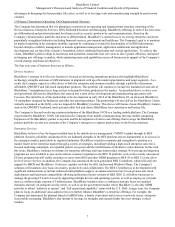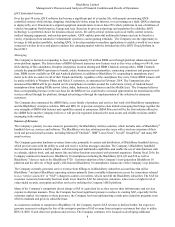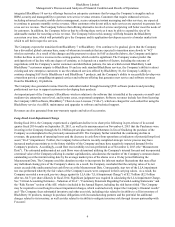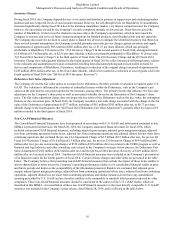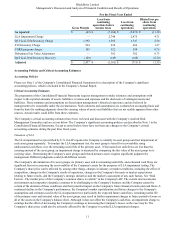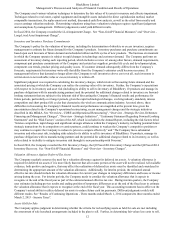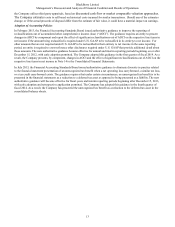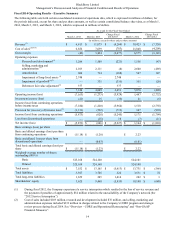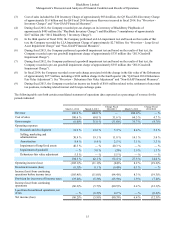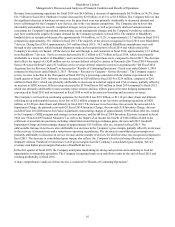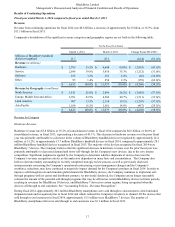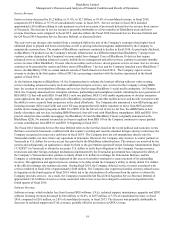Blackberry 2014 Annual Report Download - page 138
Download and view the complete annual report
Please find page 138 of the 2014 Blackberry annual report below. You can navigate through the pages in the report by either clicking on the pages listed below, or by using the keyword search tool below to find specific information within the annual report.BlackBerry Limited
Management’s Discussion and Analysis of Financial Condition and Results of Operations
8
QNX Embedded business
Over the past 30 years, QNX software has become a significant part of everyday life, with people encountering QNX-
controlled systems while driving, shopping, watching television, using the Internet, or even turning on a light. QNX technology
is deployed by over 40 automotive original equipment manufacturers in more than 250 vehicle platforms in tens of millions of
vehicles throughout North America, Europe and Asia. Based on its proven technology and reputation for reliability, QNX
technology is a preferred choice for mission-critical, secure, life safety-critical systems such as air traffic control systems,
medical imaging equipment, and nuclear power plants. QNX enables powerful multimedia features and can be found in a
variety of products from automotive infotainment systems to casino gaming terminals. The Company sees the opportunity to
leverage its full product portfolio, including QNX, to develop machine-to-machine applications to enable a world of ever-more
connected wireless devices and plans to address this emerging market with the introduction of the QNX Cloud platform in
fiscal 2015.
Messaging
The Company is focused on expanding its base of approximately 85 million BBM users through platform enhancements and
cross-platform support. The latest release of BBM delivered numerous new features such as free voice calling over Wi-Fi, one-
click sharing of files and photos, Dropbox integration, location sharing and BBM Channels, among others. BBM Channels
extends the popular BBM experience to brands, artists, businesses and communities, connecting consumers and groups in real-
time. BBM is now available on iOS and Android platforms, in addition to BlackBerry 10, responding to smartphone users'
desire to be able to connect to all of their friends and family, regardless of the smartphone they carry. Future BBM releases will
be made available to Windows Phone and Nokia X customers, as announced in February 2014. The Company has also
announced that BBM will be pre-loaded on LG smartphones in markets around the world and a variety of Android-based
smartphones from leading OEMs across Africa, India, Indonesia, Latin America and the Middle East. The Company believes
that a corresponding increase in the user base for the BBM service could lead to increased opportunities for monetization of the
services offered through the platform, through advertising or through the implementation of the solutions by enterprise
customers.
The Company also announced the eBBM Suite, a new family of products and services that work with BlackBerry smartphones
and the BlackBerry enterprise solution, BES and BES 10, to provide enterprise-class mobile messaging that brings together the
core strengths of BBM with features and capabilities aimed at enterprises. BBM Protected will be the first solution offered in
the eBBM Suite and the Company believes it will provide regulated industries the most secure and reliable real-time mobile
messaging in the industry.
Sources of Revenue
The Company’s primary revenue stream is generated by the BlackBerry wireless solution, which includes sales of BlackBerry®
handheld devices, services and software. The BlackBerry wireless solution provides users with a wireless extension of their
work and personal email accounts, including Microsoft® Outlook®, IBM® Lotus Notes®, Novell® GroupWise® and many ISP
email services.
The Company generates hardware revenues from sales, primarily to carriers and distributors, of BlackBerry handheld devices,
which provide users with the ability to send and receive wireless messages and data. The Company’s BlackBerry handheld
devices also incorporate a mobile phone, web-browsing and multimedia capabilities and enable the use of data functions such
as calendar, address book, task and memo lists and other functions associated with personal organizers. During fiscal 2014, the
Company continued to launch new BlackBerry 10 smartphones including the BlackBerry Q10, Q5 and Z30 as well as
BlackBerry 7 devices such as the BlackBerry 9720. Customer adoption of the Company’s next-generation BlackBerry 10
platform and the delivery of high quality, full-featured BlackBerry 10 smartphones remain one of the Company’s top priorities.
The Company currently generates service revenue from billings to its BlackBerry subscriber account base that utilize
BlackBerry 7 and prior BlackBerry operating systems primarily from a monthly infrastructure access fee (sometimes referred
to as a “service access fee” or “SAF”) charged to carriers or resellers, who in turn bill the BlackBerry subscriber. The SAF for
consumer customers historically has been much lower than the SAF for enterprise customers, who receive a higher level of
value-added security, encryption and other services by utilizing the Company’s BES platform.
Many of the Company’s competitors do not charge a SAF or equivalent fee as they recover their infrastructure and services
expense in alternate manners. Thus, the Company has faced significant pressure to reduce its existing SAF, especially for the
consumer market. In response to these pressures, the Company has been implementing certain price reduction programs in an
effort to maintain and grow its subscriber base.
As customers continue to transition to BlackBerry 10, the Company expects SAF revenue to decline further, but expects to
generate revenues to mitigate the loss of the enterprise portion of SAF revenue from enterprise customers that elect to utilize
BES 10, BES 12 and other new products and services. The Company continues to be focused on developing additional


